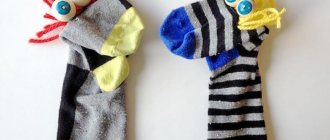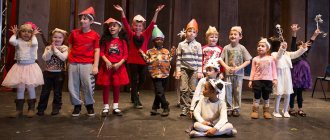“Let’s give children a fairy tale”: Theater in kindergarten
- December 30, 2014
Competition “My Pedagogical Initiative - 2014”
Nomination “Methodological work in preschool educational institutions”
I invite you to the wonderful world of children's theater.
Theater is bright positive emotions, thanks to which we have the opportunity to manage the formation of a child’s spiritual needs, enrich and develop his personality.
The main goal of my work with children is the development of the creative personality of a preschool child. I found the only correct and effective, interesting way for myself and the children to realize this goal - organizing theatrical activities in kindergarten. I have been working in this direction for several years now. During this time, my students and I, with the help of colleagues and parents, together we built our children's theater.
The building of our theater is firmly based on the basic principles:
- the principle of visibility and accessibility . This principle is based on the fact that theatrical activity is close and understandable to the child, as it is inextricably linked with play;
- the principle of freedom and independence , which allows the child to choose his own role in the action and determine his attitude towards this role;
- the principle of combination , which allows the use of collective and individual forms and methods of work, which makes it possible to develop the child’s creative personality in a variety of activities;
- the principle of systematicity and consistency , which is implemented in the fact that classes are held within the framework of a theater studio.
In the windows of our theater you see the cheerful faces of the children, they seem to invite us to enter. Let's climb these steps, enter the hospitable, wide open doors and plunge into the magical world of theatrical activities in kindergarten.
Classes with children in our theater are based on the use of theatrical pedagogy, adapted for children, with increased play moments. Work is carried out in the following areas:
- culture and technique of speech;
- rhythmoplasty;
- fundamentals of theatrical culture;
- work on the play.
Each direction solves a group of problems.
Culture and technique of speech. Not only for actors - for all people it is necessary to have intelligible, coherent, correct, competent and beautiful speech. In theater classes, children's speech apparatus is improved, speech breathing and correct articulation, diction, and speech development are developed. We use different materials: articulatory exercises for the lips and tongue, tongue twisters, tongue twisters and poetry, breathing and voice exercises, and intonation expressiveness.
Rhythmoplasty. This section includes complex rhythmic, musical, plastic games and exercises designed to develop coordination of movements, teach how to create images of animals using plastic arts, and help children gain a sense of harmony between their body and the world around them.
Fundamentals of theatrical culture. Theater is not only a performance, but also a whole world of new words and concepts that are not used in everyday life. This is the “stage”, “curtain”, “backstage”. Acquaintance with many more amazing words and concepts awaits those who wish to look behind the scenes of the theater.
Work on the play is based on original plays based on Russian folk tales.
The fairy tale also pleases us, adults, with optimism, kindness, love for all living things, and compassion for the weak. A fairy tale educates morality, because through a fairy tale, children first come into contact with the understanding of good and evil, hard work and laziness, love and hatred and other moral concepts. Children's favorite fairy tales “Turnip”, “Kolobok”, “Teremok” are easily dramatized.
In the older group, children can already create full-fledged performances based on the fairy tale. A child, entering a fairy tale, gets the role of one of the heroes, thereby getting closer to the culture of his people, to our value system, to the Russian mentality. And with what pleasure children change clothes, creating a new image! The composition is created by children mainly for child viewers. Therefore, there is always a special atmosphere of trust in everything that happens on stage in the hall. It unites both performers and spectators in a single creative impulse.
Theater activities require children to be systematic in their work, hard work, determination, and perseverance in achieving goals, and this leads to the development of strong-willed personality traits, which is a good basis not only for subsequent studies at school, but also for success in later life.
Just as it is impossible to build a large and beautiful building alone, it is also impossible to create a theater alone. The enthusiastic, creative workers of our kindergarten are happy to play different roles in entertainment and leisure, theatrical activities, at holidays, and, of course, involve children in theatrical activities. During this time, we have accumulated considerable experience, and the costume department has been replenished with bright, beautiful costumes.
The theater combines all types of art, which makes it possible to talk with children not only about its history, but also about painting, architecture, the history of costume and decorative arts. I am convinced that only in the process of theatrical activity is the comprehensive development of a child’s creative personality possible. Theater education helps to identify and prepare the most gifted and capable children. They may not become great actors, but they will certainly grow up to be bright, talented, creative individuals.
Our children develop new skills and abilities in the process of theatrical activity:
- they can pronounce tongue twisters at different tempos;
- are able to act in concert;
- know how to relieve tension from individual muscle groups;
- know how to build a simple dialogue;
- know several articulation exercises;
- are able to pronounce a phrase with different intonations.
The process of creating a fairy tale captivates the children so much that they know each other’s words, sing songs from the play both on a walk and in the evening, putting books on the table and imitating playing the piano, and even at home. In the diagram you see how the number of children with a high level of knowledge and skills in all sections of theater activities has increased compared to the beginning of the school year.
There are different paths leading to the building of our children's theater. The path for communication with parents is lined with pink pebbles. They present all types of work with parents of pupils:
- individual conversations;
- reports;
- open days;
- open viewings of performances, holidays, fairy tales, games;
- joint work on the preparation of theatrical performances.
This path initially had one direction - from the children's theater to the parents. But gradually, parents began to understand the need for theatrical work in kindergarten, saw the children’s development and interest in such activities, and began to actively help us in preparing performances, their design, and selection of attributes.
Another path is a connection with the school and the House of Children's Creativity. We are largely connected with the school by the fact that the children of teachers from MBOU Losevskaya Secondary School No. 1 attend the group; they are also enthusiastic people and open to helping us. From DDT, we have a theater studio “Buratino” in our kindergarten.
Green arrows show the creative growth of the children's team. This is our road to the future. We already have experience in showing performances for children of other groups in our kindergarten, performing for parents, and staging performances at regional seminars and methodological associations, I think we are quite capable.
Theater activities in kindergarten help us, adults, not only to embody our ideas and demonstrate our talents, but also to remain, in a sense, children. And it gives our students the joy of communicating with a fairy tale, emotional pleasure and unforgettable impressions for a lifetime!
Appendix 1: Culture and technique of speech
Appendix 2: Rhythmoplasty
Author: Nagornaya Maria Dmitrievna, teacher of the MK preschool educational institution Losevsky kindergarten No. 1, Pavlovsk district, Voronezh region.





